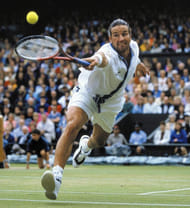The Art of Serve and Volley
A well directed top spin ‘kick’ serve to the backhand, followed by a crisp volley. This was the most trusted formula for grass court players, particularly at Wimbledon. The likes of John McEnroe, Jimmy Connors, Peter Sampras, Richard Krajicek, Boris Becker, Stefan Edberg and others used this formula to great effect at the Championships. Even Bjorn Borg, a man who dictates points from the baseline incorporated serve and volley while playing at Wimbledon.
The courts were quick, giving less time to the returner to hit passing shots. These players had a fine touch on their volleys, to finish off points. Rallies were shorter, with fewer shots played, and breaks of serve were almost like gold. The grass near the service line would be worn out towards the end of the tournament, with players running and shuffling in that area more than the baseline, which was relatively unharmed.
Fast forward to the present day. Though the points are still relatively short compared to other surfaces, the one-two punch of a big serve followed by a strong volley, is seldom seen.
The ‘old school’ style of tennis seems to have been lost, but it is various other changes in the game that have led to this. The courts, though relatively faster than other surfaces, are slower than they used to be, giving the returner that extra split second on the return, making it more difficult and perhaps risky, to approach the net with regularity. Racquets, and therefore the style of grips, too have changed. Players now tend to use the ‘Western’ grip more, enabling more top spin on the ball. Again, this makes volleying tougher, with the ball dipping on the player. Then of course, there are the balls, to which more felt has been added, making them travel that little bit slower through the air.
The final between Goran Ivanisevic and Pete Sampras on Centre Court in 1994, was believed to be a turning point. With both players using their big serve, and following it to the net, points were short, mostly lasting one or two shots. Changes in the speed of the courts and weight of balls were implemented to give baseline players more of a chance. However, racquet technology was also enabling more powerful hitting, so the players with big serves weren’t too affected, but it was the volleyers who suffered.
Baseline Domination
Since then, slowly but surely, the game started favouring the baseliners more than the serve and volley players. Pete Sampras kept winning till 2000 though, and in the following year, Goran Ivanisevic, also a serve and volley player, took the title. In 2002, Lleyton Hewitt became the first baseline player to win Wimbledon since Andre Agassi in ’92, and since then, there hasn’t been a serve and volley player who has won on the grass of Wimbledon.
The last few top class serve and volley players included Tim Henman and Patrick Rafter, both of whom came close to, but never won Wimbledon. Since then, with all the changes in the game, the art of serve and volley tennis has died. Moreover, there is very little scope for this style in the modern game. The trend is more towards hitting big groundstrokes from deep in the court, rather than delicate touch and guile at the net. Even players like Roger Federer, who has a fantastic volley, choose to approach the net very selectively.
This is not to say that the modern game is not good to watch, it provides a very different kind of entertainment and intensity. Groundstrokes are more precise, and points tend to be longer and perhaps more interesting. The game is still beautiful and more exciting than ever, with the competition getting tougher every year. However, one can’t help but miss the beauty of serve and volley tennis.
Who Are Roger Federer's Kids? Know All About Federer's Twins

